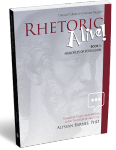Rhetoric Alive! teaches Aristotle’s classical principles of rhetoric within the context of a Christian worldview and within both timeless and present-day situations. The title of the last chapter, “The Good Student Speaking Well,” reflects the overarching goal of the course—teaching students to speak the good, the true, and the beautiful, and to do it well. The author also states two other purposes: “to be a breath of fresh air to the discipline itself, one that would reinvigorate the soul of rhetoric…” and to offer instruction in the practice of rhetoric. The course often uses topics and assignments that are likely to be pertinent to those ends, and it offers students frequent opportunities to practice speaking before an audience.
The course has 15 chapters, although the final chapter is only a brief conclusion rather than a full chapter. Each chapter teaches new concepts, uses a particular speech or text for analysis and discussion, provides one or more workshop activities, and concludes with a student presentation.
Students will learn classical rhetoric but in a easy-to-use, modern fashion. Excerpts from Aristotle’s Rhetoric are included in the textbook, and the course covers the components of persuasion: the three appeals, the three types of speech, and the five canons. Students read from other ancient sources as well; the first chapter, for example, includes the cave dialogue from Plato’s The Republic, and Chapter 14 includes Gorgias of Leontini’s Encomium of Helen. But students also read and discuss excerpts from famous speeches and writings across time such as St. Augustine’s Confessions, Shakespeare’s Julius Caesar, Martin Luther King Jr.’s “Letter from Birmingham City Jail,” and John F. Kennedy’s speech “Ask Not What Your Country Can Do for You.” (No extra books are required.)
Rhetoric Alive! adheres to the essential structure of classical rhetoric without overloading the student with too much unfamiliar jargon as I’ve encountered in some rhetoric courses. Students practice applying what they have learned in diverse contexts in both the workshop and presentation activities in each chapter. Workshop activities frequently require writing or interaction. Some examples of workshop activities are analyzing advertisements, composing emails for different audiences, writing a college application essay with a focus on the student’s own character, working on different strategies for memorization, unscrambling the parts of a speech (which will show how well organized the speech was), and playing a Jeopardy game to work on topics and relationships between among those topics.
Presentations begin with students giving renowned speeches composed by famous orators, concentrating primarily on speaking loudly, clearly, and slowly. Next, they recite a poem, this time concentrating on how to use their voices to evoke emotions in their listeners. Through these and other presentations of already written material, students gradually build up to writing and giving their own material for a presentation assignment in Chapter 7. Other presentation assignments are sometimes a mix of original material with some imitation, such as the assignment for Chapter 12 where students write a variation of General MacArthur’s “Duty, Honor, Country” speech by substituting other virtues or priorities for a group such as a school, family, or club.
The course consists of a teacher’s edition and a student textbook. The teacher’s edition is mostly the same as the student book, but it adds overprinted answers and extra teaching notes. The consumable student textbook has space for students to write answers to questions in the book.
The target audience is students in grades 11 and 12. The course can be completed in either one or two semesters, and students should earn a half credit. It definitely works best in a group class situation. Obviously, having an audience for presentations is necessary, but the course also has many other interactive group activities that are critical components of the lessons. It seems to me that each chapter requires at least two or three group meetings to have time for discussions, most workshop activities, and the presentations. So the number and timing of group class sessions you need to schedule might dictate whether you use the course in one or two semesters.
The teacher will need to read and prepare, but the teacher’s manual is so well written that the teacher need not be trained in rhetoric before teaching this course.
Summary
In my opinion, Rhetoric Alive! seems to have pulled together all of the right elements. It uses Aristotle’s time-tested framework for teaching rhetoric. By using influential and edifying speeches and writings for much of its material, it educates students indirectly about important ideas while also providing worthy models to learn from and imitate. Combining these features with scenarios and applications that are both real-life and practical applications motivates students by immediately giving them ways to use what they are learning. And the gentle progression for students to develop public speaking skills through regular presentations helps them gradually become confident speakers. All of these features make Rhetoric Alive! an outstanding course.
Note: You might want to have high school seniors also use Rhetoric Alive! Senior Thesis Student Workbook.











